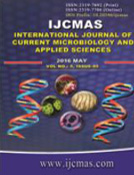


 National Academy of Agricultural Sciences (NAAS)
National Academy of Agricultural Sciences (NAAS)

|
PRINT ISSN : 2319-7692
Online ISSN : 2319-7706 Issues : 12 per year Publisher : Excellent Publishers Email : editorijcmas@gmail.com / submit@ijcmas.com Editor-in-chief: Dr.M.Prakash Index Copernicus ICV 2018: 95.39 NAAS RATING 2020: 5.38 |
Hepatic steatosis is a frequent cause for elevated serum aminotransferase levels. The main screening method is ultrasonography. A combination of non-invasive tests may help in the diagnostic evaluation of a patient with suspected steatosis. Liver biopsy is the gold standard to precisely diagnose NASH. In this study we assessed the usefulness of hepatic steatosis index in comparison with ultrasonography and histopathological examination in the evaluation of steatosis associated with HCV infection. This study was carried out at Tropical medicine department (Tanta University Hospital). We studied fifty HCV patients who have bright liver in ultrasound. All patients were further studied with histopathological examination of liver biopsy as well as lab investigations. Hepatic steatosis index was also calculated. A significant positive correlation has been found between hepatic steatosis index (HSI) and Metavir staging of fibrosis assessed by histopathological examination. When the mean value of HSI = 35.5, the stage was F0 and when the mean value of HSI = 43.7, the stage was F3. A significant positive correlation has also been found between hepatic steatosis index and histopathological grading of steatosis. When the mean value of HSI = 31.7, the grade was G0 and when the mean value of HSI = 39.1, the grade was G3. Hepatic steatosis index may offer an economical noninvasive tool for predicting of hepatic steatosis with reasonable accuracy. In practice, the index could be used for the detection of risky patients in order to offer more advanced investigation, nutrition and life style counselling, as well as for the detection of severe steatotic patients requiring medical supervision and therapy.
 |
 |
 |
 |
 |